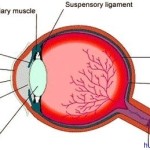Human eye, specialized sense organ in humans that is capable of receiving visual images, which are relayed to the brain. The anatomy of the eye includes auxiliary structures, such as the bony eye socket and extraocular muscles, as well as the structures of the eye itself, such as the lens and the retina.
Photons of light falling on the light-sensitive cells of the retina ( photoreceptor cones and rods) are converted into electrical signals that are transmitted to the brain by the optic nerve and interpreted as sight and vision. The size of the eye differs among adults by only one or two millimetres.
The human eye operates as similar to a digital camera in several ways: Light focuses mainly on the cornea, which acts like a camera lens. The iris controls the light that reaches the eye by adjusting the size of the pupil, and thus it functions like the diaphragm of a camera. The lens of the eye is located behind the pupil, and it focuses light.

human eye


